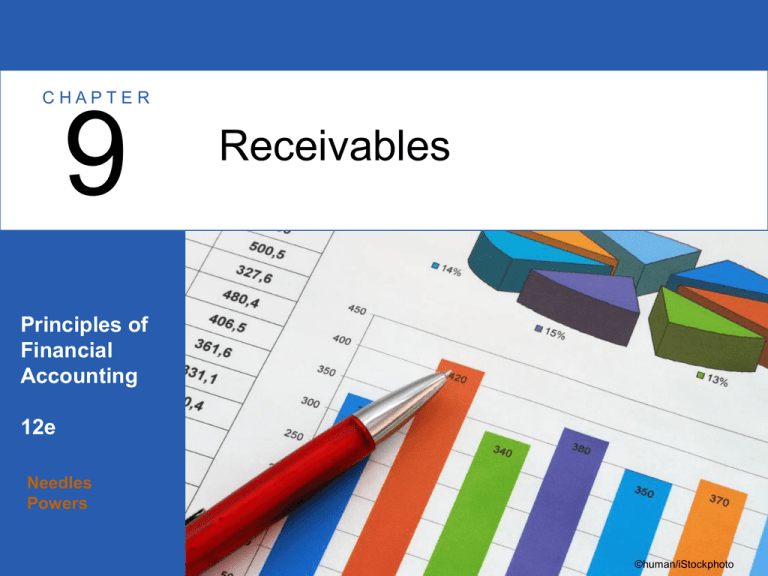
CHAPTER
9
Receivables
Principles of
Financial
Accounting
12e
Needles
Powers
©human/iStockphoto
Accounts Receivable
Accounts receivable are short-term
financial assets that arise from sales on
credit and are often called trade credit.
– In setting credit terms, a company must keep in
mind the credit terms of its competitors and the
needs of its customers.
– Companies that are too lenient in granting
credit can run into difficulties when customers
don’t pay.
©2014 Cengage Learning. All Rights Reserved. May not be scanned, copied or duplicated, or posted to a publicly accessible website, in whole or in part.
Accounts Receivable
The accounts of customers who cannot or will
not pay are called uncollectible accounts
(or bad debts).
– There are two methods of accounting for
uncollectible accounts:
Direct charge-off method: recognize a loss when an
account is determined to be uncollectible. (This is not
in accordance with accrual accounting.)
Allowance method: recognize a loss at the time
credit sales are made. (This is in accordance with
accrual accounting.)
©2014 Cengage Learning. All Rights Reserved. May not be scanned, copied or duplicated, or posted to a publicly accessible website, in whole or in part.
Notes Receivable
Notes receivable are short-term financial
assets supported by written agreements
called promissory notes.
– A promissory note is an unconditional promise
to pay a definite sum of money on demand or
at a future date.
The person or entity that signs the note and promises
to pay is the maker of the note.
The entity to whom payment is to be made is the
payee.
©2014 Cengage Learning. All Rights Reserved. May not be scanned, copied or duplicated, or posted to a publicly accessible website, in whole or in part.
The Allowance Method: Using Accrual
Accounting to Value Receivables
The allowance method is an application of
accrual accounting, which requires estimated losses
from bad debts to be matched with the revenue
they help to produce.
– It serves to value accounts receivable on the balance
sheet.
– Because management cannot identify at the time of
sale which customers will not pay or how much the
company will lose, losses from uncollectible accounts
must be estimated, and the estimate becomes an
expense in the period in which the sales are made.
©2014 Cengage Learning. All Rights Reserved. May not be scanned, copied or duplicated, or posted to a publicly accessible website, in whole or in part.
Disclosure of Receivables
A payee includes all the promissory notes it holds that are
due in less than one year as notes receivable in the current
assets section of the balance sheet.
Any interest accrued on these notes is also included in the
current assets section—as interest receivable.
Uncollectible Accounts Expense appears on the income
statement as an operating expense.
Allowance for Uncollectible Accounts appears on the
balance sheet as a contra account, deducted from accounts
receivable in the current assets section.
– It reduces the accounts receivable to the amount
expected to be collectible (net realizable value).
©2014 Cengage Learning. All Rights Reserved. May not be scanned, copied or duplicated, or posted to a publicly accessible website, in whole or in part.
Uncollectible Accounts
The allowance account is necessary because the
specific uncollectible accounts will not be identified
until later. The company’s accountant makes an
estimate based on past experience and current
economic conditions.
– Two common methods of estimating uncollectible
accounts expense are:
Percentage of net sales method—The basis for this method is
the amount of this year’s net sales that will not be collected.
Accounts receivable aging method—The basis for this
method is the amount of the ending balance of accounts
receivable that will not be collected.
©2014 Cengage Learning. All Rights Reserved. May not be scanned, copied or duplicated, or posted to a publicly accessible website, in whole or in part.
Accounts Receivable Aging Method
The aging of accounts receivable is the process
of listing each customer’s receivable account
according to the due date of the account.
– If the customer’s account is past due, there is a
possibility that the account will not be paid.
– That possibility increases as the account extends further
beyond the due date.
©2014 Cengage Learning. All Rights Reserved. May not be scanned, copied or duplicated, or posted to a publicly accessible website, in whole or in part.
Writing Off Uncollectible Accounts
The total of accounts receivable written off in a
period will rarely equal the estimated
uncollectible amount.
When it becomes clear that a specific account
receivable will not be collected, the amount should
be written off to Allowance for Uncollectible
Accounts.
©2014 Cengage Learning. All Rights Reserved. May not be scanned, copied or duplicated, or posted to a publicly accessible website, in whole or in part.
Maturity Date and Duration of a Note
The maturity date is the date on which a
promissory note must be paid. This date must be
stated on the note or be determinable from the
facts on the note.
The duration of a note is the time between a
promissory note’s issue date and its maturity date.
– Interest is calculated on the basis of the duration of a
note.
©2014 Cengage Learning. All Rights Reserved. May not be scanned, copied or duplicated, or posted to a publicly accessible website, in whole or in part.
Interest
Interest is the cost of borrowing money or the
return on lending money, depending on whether
one is the borrower or the lender. The amount of
interest is based on three factors:
– Principal (the amount of money borrowed or lent)
– Rate of interest
– Length of the loan
The formula used in computing interest is:
Principal × Rate of Interest × Time = Interest
©2014 Cengage Learning. All Rights Reserved. May not be scanned, copied or duplicated, or posted to a publicly accessible website, in whole or in part.
Maturity Value
The maturity value is the total proceeds of a
promissory note—face value plus interest—at the
maturity date.
The maturity value of a 90-day, 8 percent,
$1,000 note is computed as follows:
Maturity Value = Principal + Interest
= $1,000 + ($1,000 × 8/100 × 90/365)
= $1,000 + $19.73
= $1,019.73
©2014 Cengage Learning. All Rights Reserved. May not be scanned, copied or duplicated, or posted to a publicly accessible website, in whole or in part.
Accrued Interest
(slide 1 of 2)
Accrued interest must be apportioned to the
periods in which it belongs.
Assume that a $1,000, 90-day, 8 percent note
was received on August 31 and that the fiscal
year ends September 30. Interest for 30 days is
calculated as follows:
Principal X Rate of Interest × Time = Interest
$1,000 × 8/100 × 30/365 = $6.58
©2014 Cengage Learning. All Rights Reserved. May not be scanned, copied or duplicated, or posted to a publicly accessible website, in whole or in part.
Accrued Interest
(slide 2 of 2)
The remainder of the interest income would be
calculated as follows:
-
-
Principal × Rate of Interest × Time = Interest
$1,000 × 8/100 × 60/365 = $13.15
$6.58 of the interest would be recorded as income in
the fiscal year ending September 30, and the interest
receivable ($6.58) would be shown as received when
the note is paid.
The remainder of the interest, $13.15, would be
recorded as income in the next fiscal year.
©2014 Cengage Learning. All Rights Reserved. May not be scanned, copied or duplicated, or posted to a publicly accessible website, in whole or in part.
Dishonored Note
A note not paid at maturity is called a
dishonored note.
– The holder, or payee, of a dishonored note should
transfer the total amount due (including interest income)
from Notes Receivable to an individual account
receivable for the debtor.
©2014 Cengage Learning. All Rights Reserved. May not be scanned, copied or duplicated, or posted to a publicly accessible website, in whole or in part.
Receivables Turnover
The receivables turnover shows how many times,
on average, a company turned its receivables into
cash during a period.
– It is computed by dividing net sales by the average
accounts receivable (net of allowances).
©2014 Cengage Learning. All Rights Reserved. May not be scanned, copied or duplicated, or posted to a publicly accessible website, in whole or in part.
Days’ Sales Uncollected
Day’s sales uncollected shows, on average, how
long it takes to collect accounts receivable.
– To determine the days’ sales uncollected, the
number of days in a year is divided by the
receivables turnover.
©2014 Cengage Learning. All Rights Reserved. May not be scanned, copied or duplicated, or posted to a publicly accessible website, in whole or in part.
Factoring
Factoring is the sale or transfer of accounts receivable to
an entity, called a factor. Factoring can be done with or
without recourse.
– With recourse means that the seller of the receivables is
liable to the factor if a receivable cannot be collected.
In accounting terminology, a seller of receivables with recourse
is said to be contingently liable. A contingent liability is a
potential liability that can develop into a real liability if a
particular event occurs—in this case, a customer’s nonpayment
of a receivable.
– Without recourse means that the factor bears any losses
from unpaid accounts.
©2014 Cengage Learning. All Rights Reserved. May not be scanned, copied or duplicated, or posted to a publicly accessible website, in whole or in part.
Securitization
Securitization is a process in which a company
groups its receivables in batches and sells them at
a discount to other companies or investors.
– When the receivables are paid, the buyers get the full
amount.
– Their profit depends on the amount of the discount.
©2014 Cengage Learning. All Rights Reserved. May not be scanned, copied or duplicated, or posted to a publicly accessible website, in whole or in part.
Discounting
Discounting is a method of financing receivables
by selling promissory notes held as notes
receivable to a financial lender, usually a bank.
– The bank derives its profit by deducting the interest
from the maturity value of the note.
– The holder of the note endorses the note and turns it
over to the bank.
– The bank expects to collect the maturity value of the
note (principal plus interest), but it also has recourse
against the note’s endorser.
©2014 Cengage Learning. All Rights Reserved. May not be scanned, copied or duplicated, or posted to a publicly accessible website, in whole or in part.
Ethics and Estimates in
Accounting for Receivables
Because the amount of uncollectible accounts can
only be estimated, a company’s earnings can be
easily manipulated.
– Misstatements of earnings can occur simply because of
a bad estimate.
– They can also be deliberately made to meet analysts’
estimates of earnings, reduce income taxes, or meet
benchmarks for bonuses.
– Companies will high ethical standards try to be
accurate in their estimates of uncollectible accounts, and
they disclose the basis of their estimates.
©2014 Cengage Learning. All Rights Reserved. May not be scanned, copied or duplicated, or posted to a publicly accessible website, in whole or in part.








